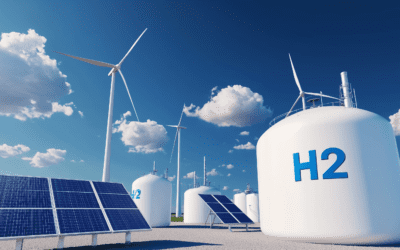
E-Fuels: A Promising Alternative for Sustainable Transportation in the Public Sector
As public sector organisations aim to reduce carbon emissions, fleet managers face the challenge of finding viable alternatives to traditional fuels. E-fuels, synthetic fuels produced from renewable electricity and captured carbon dioxide, have gained attention as a promising future solution for decarbonising transportation. As this phenomenon progress, this fuel could offer an sustainable solution for government vehicles that rely on internal combustion engines (ICEs). This article explores how this fuel could support sustainability goals, considering both their benefits and challenges for public sector fleets.
What Are E-Fuels?
E-fuels, or electrofuels, are synthetic fuels created through power-to-liquid (PtL) technology. This process involves using renewable energy, such as wind or solar power, to generate electricity, which is then used to produce hydrogen via electrolysis. The hydrogen is combined with captured carbon dioxide to synthesise a liquid fuel that can be used in traditional combustion engines, including those used in public sector fleets like buses, fire engines, and waste collection vehicles.
For public sector fleets, this could offer a renewable fuel source that aligns with broader governmental sustainability objectives. The production process follows a structured path:
- Generation of electricity from renewable sources
- Electrolysis to create green hydrogen
- CO2 capture from industrial sources or directly from the atmosphere
- Synthesis of hydrogen and CO2 to create the e-fuel product
These steps create a fuel that mimics the properties of conventional petrol or diesel, making it suitable for use without extensive changes to existing infrastructure in e-fuels for public sector fleets.
Advantages of E-Fuels for Public Sector Fleets
Carbon Neutrality
E-fuels present a carbon-neutral solution since the CO2 released during combustion is offset by the CO2 absorbed during their production. This could make them a valuable tool for public sector fleets looking to meet net-zero emission targets, especially in difficult-to-decarbonise sectors like transportation. For many public sector fleets operating in urban environments or remote areas, e-fuels for public sector fleets provide a practical way to reduce carbon footprints without requiring an overhaul of current systems.
- Compatibility with Existing Infrastructure
One of the most significant advantages of e-fuels is their compatibility with current diesel and petrol engines. Public sector fleets often consist of older vehicles, which can be costly or impractical to replace with electric counterparts. E-fuels can be used in these vehicles without requiring costly engine modifications or extensive changes to refuelling infrastructure. This “drop-in” capability makes the transition to sustainable energy far more feasible for cash-strapped government departments. - Versatility Across Transport Modes
Public transport services, emergency vehicles, and heavy-duty trucks—all crucial components of public sector fleets—can benefit from e-fuels. They are particularly advantageous for long-haul applications where electrification is either inefficient or impractical. The versatility of e-fuels allows fleet managers to address various transport needs under a unified fuel solution, making them a suitable choice for diverse operations like police vehicles, ambulances, and large waste collection trucks that require dependable, on-demand power. - Long-Term Energy Storage and Transport
E-fuels can be stored and transported like conventional fuels, offering a significant advantage over renewable electricity, which faces storage and transmission challenges. This is particularly valuable for public sector operations that require reliability and flexibility. For instance, rural emergency services or local governments operating in areas with limited electric vehicle infrastructure would benefit from e-fuels’ ease of distribution. Furthermore, e-fuels provide a strategic energy reserve that can be drawn upon as needed, unlike electricity which can face grid limitations during peak demand. - Reduced Emissions of Harmful Pollutants
In addition to being carbon-neutral, e-fuels emit fewer nitrogen oxides (NOx) and particulate matter compared to conventional fossil fuels. This reduction in harmful emissions is essential for improving air quality in cities and towns where public sector fleets operate. As governments increasingly prioritise public health and clean air initiatives, the ability of e-fuels to reduce local pollution could play an important role in fleet decisions. This is especially relevant for urban public transportation and refuse collection vehicles that operate in residential areas.
Challenges Facing E-Fuels in the Public Sector
- High Production Costs
The current cost of producing e-fuels for public sector fleets is significantly higher than that of traditional fossil fuels. This is primarily due to the need for large amounts of renewable energy and advanced technology to synthesise the fuels. For public sector fleets, which operate within tight budget constraints, these costs may hinder widespread adoption unless government subsidies or other financial incentives are introduced. Public sector organisations may need to balance the long-term environmental benefits of e-fuels for public sector fleets with the short-term financial implications of their use. - Energy Efficiency Concerns
E-fuel production involves multiple stages of energy conversion, leading to inefficiencies compared to direct electrification or HVO fuel. Producing hydrogen via electrolysis, capturing CO2, and combining the two to create a fuel requires significantly more energy than simply charging an electric vehicle (EV). For public fleet managers looking to maximise operational efficiency, this inefficiency may be a concern, particularly when considering total energy use, lifecycle emissions, and cost-effectiveness in the long term. - Scalability and Availability
E-fuels for public sector fleets are not yet produced at the scale necessary to meet the demands of large government-operated vehicle fleets. The infrastructure for mass production and distribution is still developing, meaning that availability may be limited. For local governments aiming to transition entire fleets, this presents a significant challenge. Scaling up production will require substantial investment in both technology and infrastructure, as well as partnerships with energy providers to ensure reliable supply chains. - Environmental Impact
While e-fuels for public sector fleets are cleaner than fossil fuels, they still emit CO2 and other pollutants when burned. Although the overall process is considered carbon-neutral due to the captured CO2 used in production, e-fuels do not eliminate harmful emissions entirely. Public sector fleet managers must weigh these residual emissions against the benefits of transitioning to e-fuels. In areas with strict emission regulations, such as city centres with low-emission zones, this may limit their appeal compared to zero-emission alternatives like electric or hydrogen fuel cell vehicles.
Applications and Future Prospects in the Public Sector
E-fuels for public sector fleets hold particular promise for operations that require vehicles with long-range capabilities, such as emergency services, heavy-duty trucks, and rural transportation. Their ability to decarbonise sectors that are difficult to electrify makes them a potential cornerstone of government sustainability strategies. Public sector entities, particularly those managing diverse vehicle fleets, are well-placed to adopt e-fuels for public sector fleets as part of their broader decarbonisation efforts.
To unlock the full potential of e-fuels for public sector fleets, several factors will be essential:
- Technological Innovation: Advancements in production efficiency are needed to lower costs and improve energy output. Investments in research and development are critical to ensuring that e-fuels become more viable for mass use.
- Policy Support: Government policies that encourage the adoption of e-fuels—such as tax incentives, research grants, and infrastructure investments—will be crucial to overcome economic and scalability challenges. Public procurement policies could mandate the use of e-fuels in government-operated fleets, driving demand.
- Public Investment: Continued investment in research and pilot programs can drive down costs, making e-fuels for public sector fleets more competitive with fossil fuels and other alternatives. Public sector partnerships with energy companies could accelerate the deployment of e-fuel technologies.
- Infrastructure Development: Expanding e-fuel production facilities and distribution networks will ensure that public sector fleets have reliable access to this renewable energy source. This includes building refuelling stations and improving supply chains.
Conclusion
While e-fuels for public sector fleets may not yet be the most cost-effective or efficient solution for every fleet, their compatibility with existing vehicles, carbon-neutrality, and versatility makes them an appealing future option for the public sector. For fleet managers and policymakers striving to balance environmental goals with operational demands, e-fuels for public sector fleets offer a potential promising solution as it continues to evolve. By investing in the development of e-fuel infrastructure and supporting policies, amongst other renewable fuel options, public sector organisations can position themselves at the forefront of sustainable transportation, ensuring a greener future for their communities.








